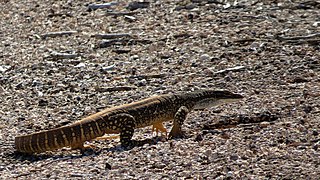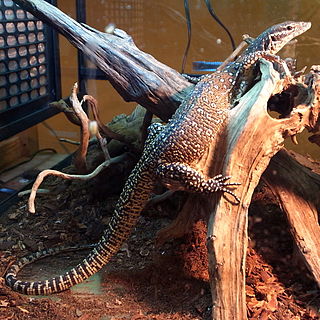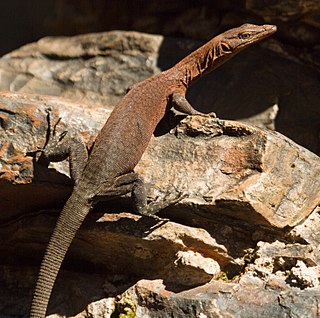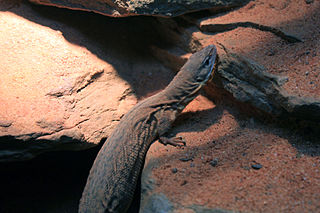
Monitor lizards are large lizards in the genus Varanus. They are native to Africa, Asia, and Oceania, and one species is also found in the Americas as an invasive species. About 80 species are recognized.

A goanna is any one of several species of lizards of the genus Varanus found in Australia and Southeast Asia.

The sand goanna is a species of large Australian monitor lizard, also known as Gould's monitor, sand monitor, or racehorse goanna.
The short-tailed pygmy monitor is the second smallest living monitor lizard in the world with a maximum length of 25 cm.

Varanus timorensis, the Timor monitor or spotted tree monitor, is a species of small monitor lizards native to the island of Timor and some adjacent islands.

The yellow-spotted monitor, also known as the Argus monitor, is a monitor lizard found in northern and western regions of Australia and southern New Guinea.

The spiny-tailed monitor, also known as the Australian spiny-tailed monitor, the ridge-tailed monitor or Ackie's dwarf monitor, is an Australian species of lizard belonging to the genus of monitor lizards (Varanus).

The peacock monitor, also known commonly as Auffenberg's monitor, is a species of small monitor lizard in the family Varanidae. The species, which belongs to the subgenus Odatria, is endemic to Rote Island, Indonesia.

The stripe-tailed goanna, also known as the line-tailed pygmy monitor is a semi-arboreal species of monitor lizard native to Western Australia.

The Kimberley rock monitor is a medium-sized species of monitor lizard in the family Varanidae. The species is native to Northern Australia. Also known as Glauert's monitor or the Kakadu sand goanna, it belongs to the subgenus Odatria.
The Pilbara monitor, also known commonly as Bush's monitor, Bush's pygmy monitor, and the Pilbara mulga goanna, is a species of monitor lizard in the family Varanidae. The species is endemic to Australia.

The Rosenberg's monitor is an Australian species of varanid reptile found in southern regions of the continent. They are large and fast predators with rugged bodies and long tails, having a combined length up to 1.5 metres, that will consume any smaller animal that is pursued and captured or found while foraging. They occur in the Australian Capital Territory, New South Wales, South Australia, Victoria, where it may be rare or locally common, and more frequently observed in Western Australia, where it is sometimes abundant.
The black-spotted ridge-tailed monitor, also called commonly the black-spotted spiny-tailed monitor, the lemon-throated monitor, the northern ridge-tailed monitor, Whites monitor, and the yellow-throated monitor, is a species of lizard in the family Varanidae. The species is native to Australia's tropical Northern Territory. It is listed as Least Concern on the IUCN Red List as it is considered common and not threatened. It was first described in 1987. It is also known as White's dwarf goanna.

Kings' monitor, also known commonly as Kings' goanna, Kings' rock monitor and pygmy rock monitor, is a small species of monitor lizard in the family Varanidae. The species is native to Australia.

The Southern Pilbara rock goanna, also known as the Hamersley Range rock monitor, is a dwarf member of the family Varanidae.
The Dampier Peninsula monitor or Dampier Peninsula goanna, described in 2014, is the smallest known species of monitor lizard, growing up to 16.3 grams with a length of almost 23 cm and a SVL of 116 mm. It is believed to live only on the Dampier Peninsula of the Kimberley region north of Broome and Derby in Western Australia. It is highly active, making it difficult to photograph in the wild. It has short legs, an elongate body, a reddish-brown back with widely scattered black spots and "a ridged, circular and short prehensile tail."
"sparnos is Greek for 'rare' or 'scarce' in reference to this species' isolation and small range on the Dampier Peninsula. Latinised to sparnus, and used as an adjective".

Storr's monitor is a species of monitor lizard in the family Varanidae. The species is endemic to Australia.
The Pilbara rock monitor is a small member of the family Varanidae endemic to the Chichester Range in North West Australia.

The subgenus Odatria, sometimes known as the dwarf monitor lizards, consists of small monitor lizards found in Australia and Indonesia. Species in this subgenus include the smallest monitor species in the world, the tiny 16 gram Dampier Peninsula monitor, but also includes some more medium sized species such as the 240 gram black-palmed rock monitor.














